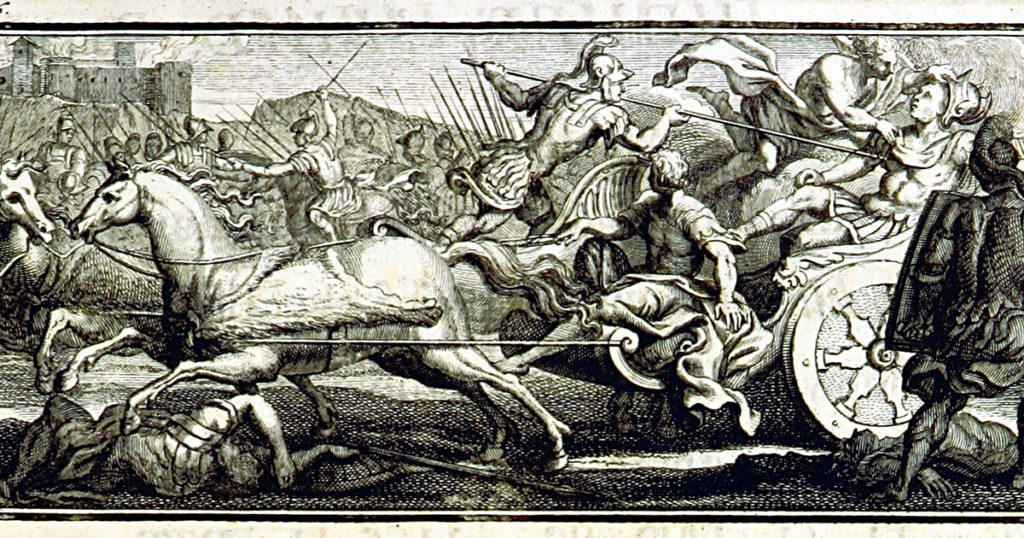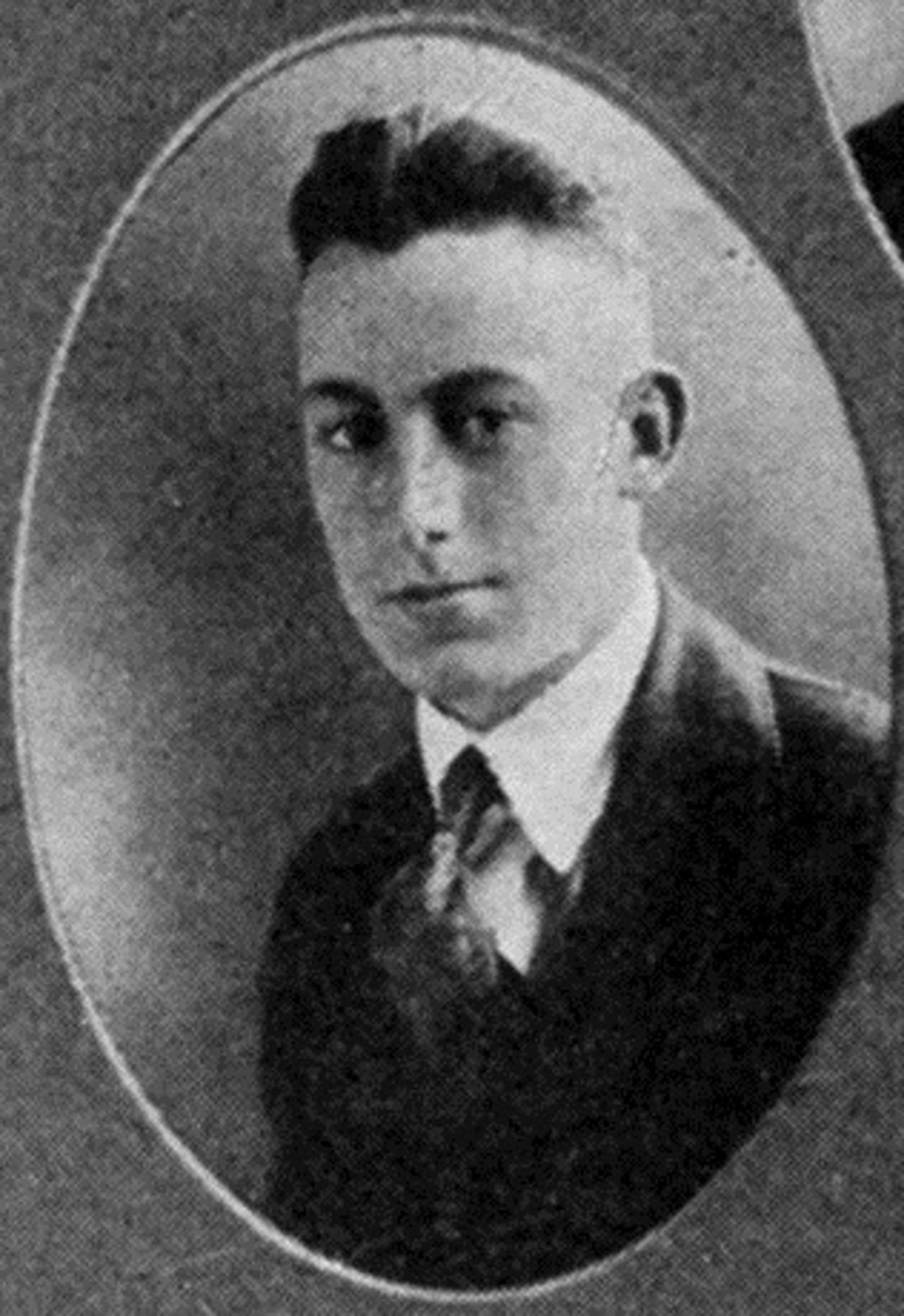
Hearing Homer’s Song: The Brief Life and Big Idea of Milman Parry by Robert Kanigel; Knopf, 352 pp., $27.95
In 1923, with the Jazz Age and the Roaring Twenties in full swing, a young man fresh out of college spent a summer on a Los Angeles beach reading Homer, in Greek. As legend has it, all at once a wild surmise swam into his ken. For the rest of his short life, he would develop and expand on this “big idea”—one that would not only upend centuries of Homeric scholarship but even give rise to a new discipline: the study of the oral tradition.
If that moment is cinematic—a youth in golden sunshine beside the ocean—then Milman Parry’s death at the age of 33 is a scene straight out of Hollywood film noir: a seedy hotel room in 1935 Los Angeles, a handgun stashed in a suitcase, and a dark-haired dame (his long-suffering wife) with reason to resent him. The words accident, suicide, and even murder swirl like smoke around his demise.
Robert Kanigel is interested in “genius.” His 1991 book, The Man Who Knew Infinity: A Life of the Genius Ramanujan, was even made into a movie with Jeremy Irons and Dev Patel. His biography (the first) of Parry, set in California, Paris, Yugoslavia, and Cambridge, Massachusetts, would translate well to the big screen (or Netflix). Although an ideal beach read for the classics scholar, the book is aimed at the layperson; Kanigel eschews jargon and in-depth technical discussion while still attempting to convey the magnitude of Parry’s theory, which tackled the thorny “Homeric question”—the puzzle of how the Iliad and the Odyssey were authored, and by whom, including the identity and historicity of Homer—by rendering it “irrelevant.”

Parry as pictured in the Oakland Technical High School yearbook in 1919 (History and Art Collection/Alamy)
A tag from the Roman poet Horace asserts that “even Homer nods,” and indeed, continuity is not Homer’s forte. In one scene in the Iliad, for example, three men—Odysseus, Ajax, and Phoenix—are sent to persuade Achilles to return to the war, but in the next line, it is a “pair” of men walking down the beach. Homer recycles scenes wholesale—arming for battle—and uses trite phrases over and over, “winged” words, “the wine-dark” sea. These epithets don’t always even make sense: ships are “swift” even when pulled up on the beach. How is it that the sublime poet (no one then doubted, as some scholars later would, that Homer had existed) at the dawn of Western literature is consistently so inconsistent?
Trying to resolve this paradox became a branch of classical scholarship in its own right. As Matthew Arnold put it in his 1861 lecture “On Translating Homer,”
I advise the translator to have nothing to do with the questions, whether Homer ever existed; whether the poet of the Iliad be one or many; whether the Iliad be one poem or an Achilleis and an Iliad stuck together … These are questions which have been discussed with learning, with ingenuity, nay, with genius ; but they have two inconveniences. … The general inconvenience is, that there really exist no data for determining them.
Arnold, so astute about Homer, was perhaps wrong in this one particular: it turns out that there are data, both within and without the poems; Parry’s “big idea,” undergirded by statistical analysis of the poems, was widely regarded in the light not of conjecture but of scientific discovery. English scholar H. T. Wade-Gery even dubbed Parry the Darwin of Homeric studies, for just as Darwin had taken God out of the Creation, Parry took the creative poet out of the Iliad and the Odyssey.
What if, he proposed, the peculiarities of Homer—the repeated epithets, the errors, the simple syntax, the mix of dialects—are not a bug but a feature of a literature not composed on the page but in the air, by preliterate bards who handed down songs over generations? The bard sings his poem into being, relying on time-polished phrases to fill out the measure, and repetitions to keep himself and his listeners oriented in the story, and as an aid to memory. The writer can revise; not so the oral bard. The bard can add on but can’t rewind. Were he to sing the tale again, it would always be slightly different—you cannot step into that same river of song twice.
Surprisingly, in the chicken-and-egg scenario, Parry’s idea emerges first, followed only later by ground-shifting evidence. At Parry’s doctoral defense in Paris, Sorbonne linguist Antoine Meillet suggested that Parry fill out his idea by studying oral composition among the illiterate bards of Yugoslavia, “guslars” who accompanied their heroic songs on the gusle, a bowed, one-stringed instrument. An early pioneer of sound recording, Parry, over two visits, amassed thousands of aluminum disks. With his knack for mechanics, he may have had a hand in designing the device used in his field research. Maddeningly, Kanigel writes, “the machine itself is lost.”
Many people were pivotal in Parry’s research and thinking: Meillet, Slovenian scholar Matija Murko, and not least, Parry’s young assistant Albert Lord, who took on the unfinished work of analyzing the aluminum disks. This task proved so daunting that he suffered a nervous breakdown; he had to leave academia for eight years, working in a naval shipyard, before he could resume. Finally, in 1960, he brought out the seminal book of their research, which he titled, significantly, The Singer of Tales.
And then there was Mrs. Parry, Marian née Thanhouser, an aspiring writer a few years older than Milman. At Berkeley, their bohemian set held progressive views on sex, but an unplanned pregnancy conventionally precipitated their marriage. (Milman’s response: “That’s the beginning of the baby and the end of me.”) The book sometimes seems to reproach Marian as genius’s indifferent helpmeet, despite Milman’s infidelity, irrational jealousy, and vaguely alluded-to “cruelties”; Marian, who came from a prosperous Jewish family, was also subjected to anti-Semitic snobbery at Harvard. Of Marian’s unhappiness in their early days in France, Kanigel writes, “How much did that owe to being a mother, stuck at home, alone with a young child, in a foreign country, the whole mix poisoned by her passivity?” Passivity? This sounds like depression. Later, when Kanigel describes a photograph of her snapped in the aftermath of Milman’s death, he writes, “Read one way, she looks guilty as hell.” Marian, prone to angry outbursts, was perhaps no Penelope, but is it fair to cast her as Clytemnestra?
No one can know for certain how the gun went off. At first, hotel staff pointed to the wife, but the police ruled it an accident. Parry’s colleagues wondered whether it was suicide. Kanigel riffs on the irony that Parry’s own life has entered an oral tradition of gossip, hearsay, folk song, and legend. A 2019 article in Oral Tradition, “The Myth of Milman Parry: Ajax or Elpenor,” treats the accounts of his death as just that.
However the Iliad and the Odyssey emerged from the oral tradition, at some point, perhaps not very long after the innovation of the Greek alphabet in the late eighth century B.C., the poems were preserved in the amber of writing. There is even a theory (proposed by Wade-Gery) that the Greek alphabet, which tweaked the Phoenician script to include vowels, was invented for this very purpose: to record the voices of poetry. Perhaps some Iron Age Milman Parry, armed with this new contraption, the alphabet, listened to the bards and set about collecting the best of those songs. American classicist Barry Powell has even ingeniously suggested, in his 1991 book, Homer and the Origin of the Greek Alphabet, that the inventor of that technology did so expressly to write down the poems we call Homer’s.

